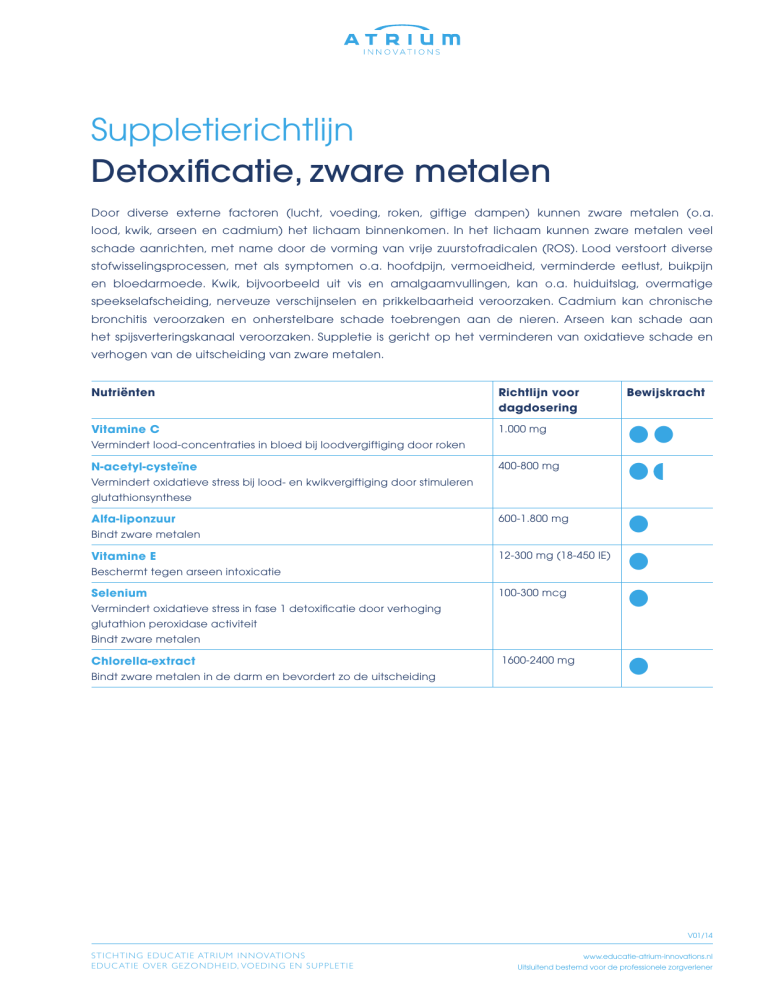
Suppletierichtlijn
Detoxificatie, zware metalen
Door diverse externe factoren (lucht, voeding, roken, giftige dampen) kunnen zware metalen (o.a.
lood, kwik, arseen en cadmium) het lichaam binnenkomen. In het lichaam kunnen zware metalen veel
schade aanrichten, met name door de vorming van vrije zuurstofradicalen (ROS). Lood verstoort diverse
stofwisselingsprocessen, met als symptomen o.a. hoofdpijn, vermoeidheid, verminderde eetlust, buikpijn
en bloedarmoede. Kwik, bijvoorbeeld uit vis en amalgaamvullingen, kan o.a. huiduitslag, overmatige
speekselafscheiding, nerveuze verschijnselen en prikkelbaarheid veroorzaken. Cadmium kan chronische
bronchitis veroorzaken en onherstelbare schade toebrengen aan de nieren. Arseen kan schade aan
het spijsverteringskanaal veroorzaken. Suppletie is gericht op het verminderen van oxidatieve schade en
verhogen van de uitscheiding van zware metalen.
Nutriënten
Richtlijn voor
dagdosering
Bewijskracht
Vitamine C
1.000 mg
●●
400-800 mg
●
600-1.800 mg
●
12-300 mg (18-450 IE)
●
100-300 mcg
●
1600-2400 mg
●
Vermindert lood-concentraties in bloed bij loodvergiftiging door roken
N-acetyl-cysteïne
Vermindert oxidatieve stress bij lood- en kwikvergiftiging door stimuleren
glutathionsynthese
Alfa-liponzuur
Bindt zware metalen
Vitamine E
Beschermt tegen arseen intoxicatie
Selenium
Vermindert oxidatieve stress in fase 1 detoxificatie door verhoging
glutathion peroxidase activiteit
Bindt zware metalen
Chlorella-extract
Bindt zware metalen in de darm en bevordert zo de uitscheiding
V01/14
S T I CH T I NG E D UC AT I E AT R I U M I N N OVAT I O N S
E D U C AT I E OV ER G EZ O N DH EI D, VO EDI N G EN S U P P LETIE
www.educatie-atrium-innovations.nl
Uitsluitend bestemd voor de professionele zorgverlener
Gerelateerde suppletierichtlijnen
• Detoxificatie, lever
• Darm reiniging en -opbouw
Aandachtspunten
• Bij het gebruik van medicijnen, zie ‘Overzicht geneesmiddelen – voedingsstatus – suppletie’ voor mogelijke interacties.
Belangrijkste referenties
• Kasperczyk S et al. The administration of N-acetylcysteine reduces oxidative stress and regulates glutathione
metabolism in the blood cells of workers exposed to lead. Clin Toxicol (Phila). 2013 Jul;51(6):480-6. Epub 2013 Jun 4.
• Dodd S et al. N-acetylcysteine for antioxidant therapy: pharmacology and clinical utility. Expert Opin Biol Ther. 2008
Dec;8(12):1955-62.
• Dawson EB et al. The effect of ascorbic acid supplementation on the blood levels of smokers. J Am Coll Nutr. 1999
Apr;18(2):166-70
• Huk-Kolega H et al. Role of lipoic acid in health and disease. Pol Merkur Lekarski. 2011 Sep;31(183):183-5.
• Patrick L et al. Mercury toxicity and antioxidants: Part 1: role of glutathione and alpha-lipoic acid in the treatment
of mercury toxicity. Altern Med Rev. 2002 Dec;7(6):456-71.
• Seppänen K et al. Effect of supplementation with organic selenium on mercury status as measured by mercury in
pubic hair. J Trace Elem Med Biol. 2000 Jun;14(2):84-7.
• Flora SJ et al. Heavy metal induced oxidative stress & its possible reversal by chelation therapy. Indian J Med
Res. 2008 Oct;128(4):501-23.
• Seppänen K et al. Effect of supplementation with organic selenium on mercury status as measured by mercury in
pubic hair. J Trace Elem Med Biol. 2000 Jun;14(2):84-7.
V01/14
S TIC H T I NG EDU C AT I E AT R I U M I N N OVAT I O N S
E D UC AT I E OV E R G E Z O NDH EI D, VO EDI N G EN S U P P L ET I E
www.educatie-atrium-innovations.nl
Uitsluitend bestemd voor de professionele zorgverlener
